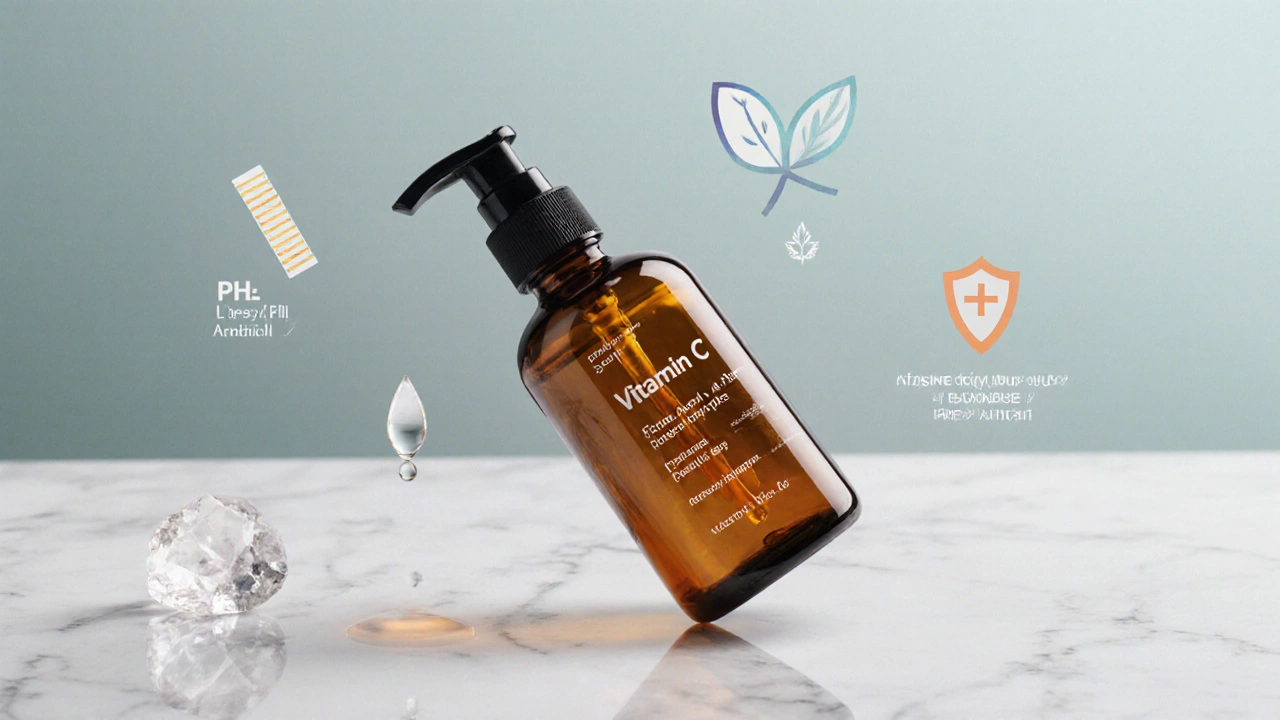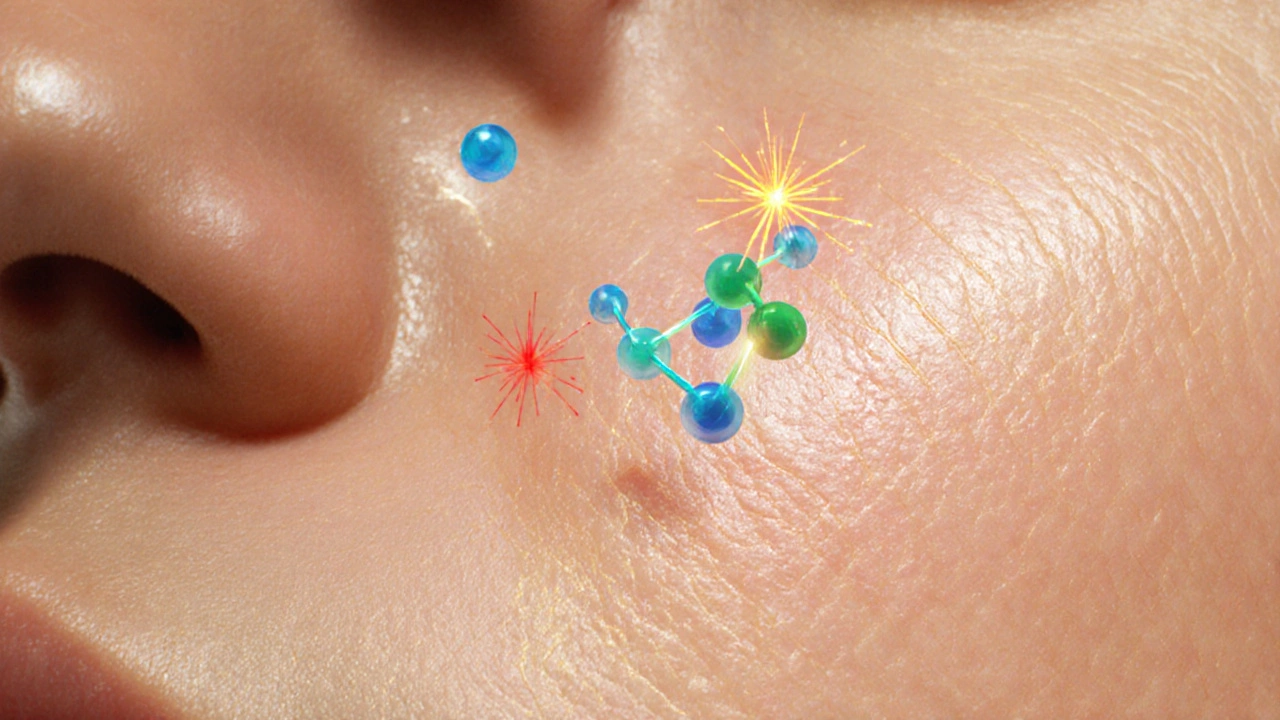Vitamin C Serum Guide
Your Personalized Vitamin C Benefits
Adjust settings above and click "Show My Vitamin C Benefits" to see personalized recommendations.
When it comes to skin care, Vitamin C is a water‑soluble antioxidant (ascorbic acid) that protects cells from oxidative damage and supports collagen production is the buzzword you hear everywhere-from high‑end salons to grocery aisles. But what does it actually do for your skin, and how can you make the most of it without wasting time or money?
How Vitamin C Works on the Skin
Vitamin C helps skin in three core ways:
- Neutralising free radicals: UV rays, pollution, and smoke generate unstable molecules called free radicals. Vitamin C donates electrons, turning those radicals harmless and preventing them from breaking down collagen and elastin.
- Boosting collagen synthesis: The vitamin is a co‑factor for the enzymes prolyl and lysyl hydroxylase, which stabilise the collagen triple‑helix. More stable collagen means firmer, smoother skin.
- Inhibiting melanin production: Vitamin C interferes with the enzyme tyrosinase, slowing down the formation of melanin and helping to fade dark spots.
Key Skin Benefits You’ll Notice
Here’s a quick rundown of what regular, properly formulated Vitamin C can achieve:
- Anti‑aging: Studies show a 10‑percent reduction in fine lines after eight weeks of twice‑daily use at 15% concentration.
- Brightening: Clinical trials report a 25‑percent drop in hyperpigmentation intensity after six weeks of 20% L‑ascorbic acid.
- Acne control: By reducing inflammation, Vitamin C calms active breakouts and speeds up post‑inflammatory redness fading.
- Sun protection boost: While it’s not a sunscreen, Vitamin C can enhance SPF by up to 8% when layered under mineral sunscreen.
- Barrier reinforcement: The antioxidant helps retain ceramides, keeping the skin barrier resilient against irritants.

Choosing the Right Vitamin C Product
Not every serum is created equal. Look for these attributes:
| Attribute | Why It Matters | Common Range |
|---|---|---|
| Form | Stability and absorption | L‑ascorbic acid, Magnesium Ascorbyl Phosphate, Sodium Ascorbyl Phosphate |
| Concentration | Effectiveness vs. irritation risk | 5‑20% |
| pH Level | Optimal for skin penetration | 2.0‑3.5 (acidic) for L‑ascorbic acid |
| Packaging | Prevents oxidation | Air‑tight, amber glass, or pump bottle |
| Additional Actives | Synergy or conflict | Ferulic acid, Vitamin E, Hyaluronic acid |
For beginners, a 10% L‑ascorbic acid serum in an opaque pump is a safe bet. Advanced users may experiment with 15‑20% formulas paired with ferulic acid and Vitamin E for extra stability.
How to Incorporate Vitamin C Into Your Routine
- Cleanse with a gentle, pH‑balanced cleanser.
- Pat skin dry and wait 1‑2 minutes for any residual water to evaporate.
- Apply a pea‑sized amount of Vitamin C serum to face and neck. Gently press, don’t rub.
- Follow with a moisturizer containing ceramides or hyaluronic acid to lock in hydration.
- Finish with a broad‑spectrum sunscreen (minimum SPF30) in the morning.
Evening use is optional; if your skin is sensitive, stick to mornings only to maximise the UV‑related protection.
Common Pitfalls and How to Avoid Them
- Oxidised serum: A yellow‑to‑brown colour shift means the vitamin has degraded. Replace it within three months of opening.
- Irritation: High concentrations (above 20%) or low pH can sting. Start with 5‑10% and build tolerance.
- Layering conflicts: Avoid using Vitamin C directly over retinol or strong AHAs in the same step; they can neutralise each other or cause excess sensitivity.
- Storage mistakes: Keep the product in a cool, dark place. Refrigeration prolongs potency.

Vitamin C vs. Other Popular Actives
| Active | Main Benefit | Typical Use Time | Best For |
|---|---|---|---|
| Vitamin C | Antioxidant, collagen boost, brightening | Morning | Uneven tone, early signs of aging |
| Retinol | Cell turnover, wrinkle reduction | Night | Deep wrinkles, fine lines |
| Hyaluronic Acid | Moisture retention | Both AM & PM | Dryness, plumping |
When used together correctly-Vitamin C in the morning and retinol at night-you cover both antioxidant defence and skin renewal without conflict.
Quick Takeaways
- Vitamin C neutralises free radicals and supports collagen, leading to firmer, brighter skin.
- Choose a stable formula (5‑20% concentration, pH2‑3.5, opaque packaging).
- Apply after cleansing, before moisturizer, and always follow with sunscreen.
- Watch for colour change; replace oxidised serum promptly.
- Pair with complementary actives-Vitamin E, ferulic acid, or hyaluronic acid-for best results.
Frequently Asked Questions
Can I use Vitamin C if I have sensitive skin?
Yes, but start with a low concentration (5% or less) and a buffered form like magnesium ascorbyl phosphate. Apply every other day and monitor for tingling.
How long does it take to see results?
Visible brightening usually appears after 4‑6 weeks, while collagen‑related firmness improvements can take 8‑12 weeks of consistent use.
Should I combine Vitamin C with sunscreen?
Absolutely. Vitamin C protects against free‑radical damage, but sunscreen blocks UV photons. Use a broad‑spectrum SPF30 or higher after applying the serum.
Is a Vitamin C supplement as effective as topical serum?
Oral vitamin C supports overall antioxidant levels but doesn’t reach the high concentrations needed at the skin’s surface. Topical application remains the most effective for visible skin changes.
Can I store my Vitamin C serum in the fridge?
Yes, refrigeration slows oxidation and keeps the formula stable longer, especially for high‑strength serums.



